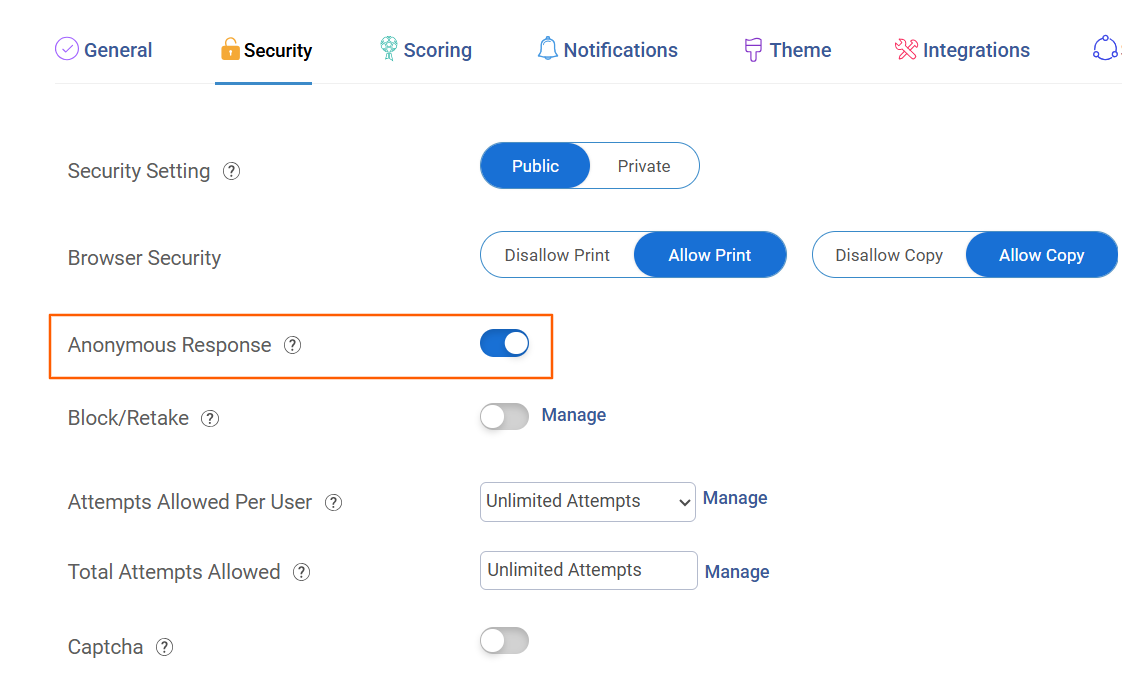If you work in a healthcare organization, you know the pressure never really stops. Patients miss appointments, phone lines overflow with rescheduling calls, and staff wrestle with EMRs that were never built for real communication. Meanwhile, you’re still expected to keep patients engaged and satisfied.
That’s why the right patient engagement software isn’t a “nice-to-have”; it’s a necessity. You need something that reduces no-shows, streamlines communication, and works with your existing systems without piling on more stress.
The challenge is choosing wisely. Some patient engagement platforms promise everything, while others are just basic survey or reminder tools. Not all of them deliver.
This guide will cut through the noise: what patient engagement software really means, the features that matter, and the top patient engagement tools (free and paid) worth your attention.
Why Patient Engagement Software Matters in 2025
Patient engagement software helps providers create meaningful interactions with patients throughout their care journey. Think secure messaging, appointment reminders, patient surveys, telehealth visits, and self-service portals, all designed to keep patients actively involved.
And the demand is only growing. The global patient engagement solutions industry was valued at $23.9 billion in 2024 and is projected to reach $104.6 billion by 2035, growing at a CAGR of 14 percent. That reflects how central these tools have become to healthcare delivery.
The reasons are clear:
- Patients expect digital convenience, the same way they do with banking or shopping.
- Providers face pressure to cut no-shows, improve satisfaction scores, and stay compliant.
- Traditional EMRs handle records but fall short when it comes to engagement.
Without the right tools, practices face the same cycle of missed appointments, fragmented communication, hidden costs, and patients who quietly switch providers. With the right patient engagement platforms, providers can change that story by unifying data, automating outreach, and giving patients more control over their care.
List of Top 10 Patient Engagement Software
With so many patient engagement platforms available, choosing the right one can be overwhelming.
Before we explore each tool’s unique features and pricing, here is a small comparison table.
| Product | Best for | Pricing |
|---|---|---|
| ProProfs Survey Maker | Comprehensive patient surveys | Free plan available. Paid plan starts at $19.99/month |
| Spruce Health | Secure patient communication | Basic plan starts at $24/month |
| NextGen Office | Seamless patient management | Contact the company for a quote |
| AthenaOne | All-in-one patient engagement | Contact the company for a quote |
| Mend | Telemedicine dispatch | Starts at $49.99/user/month |
| PracticeFusion | Patient engagement for independent practices | Starts at $149/provider/month |
| PrognoCIS | Improving overall patient experience | Starts at $249/month |
| Solutionreach | Patient communication | Contact the company for a quote |
| ModMed | Specialty-specific EHR systems | Starts at $197/month |
| RXNT | Simplifying workflow | Starts at $110/month |
1. ProProfs Survey Maker – Best for Comprehensive Patient Surveys
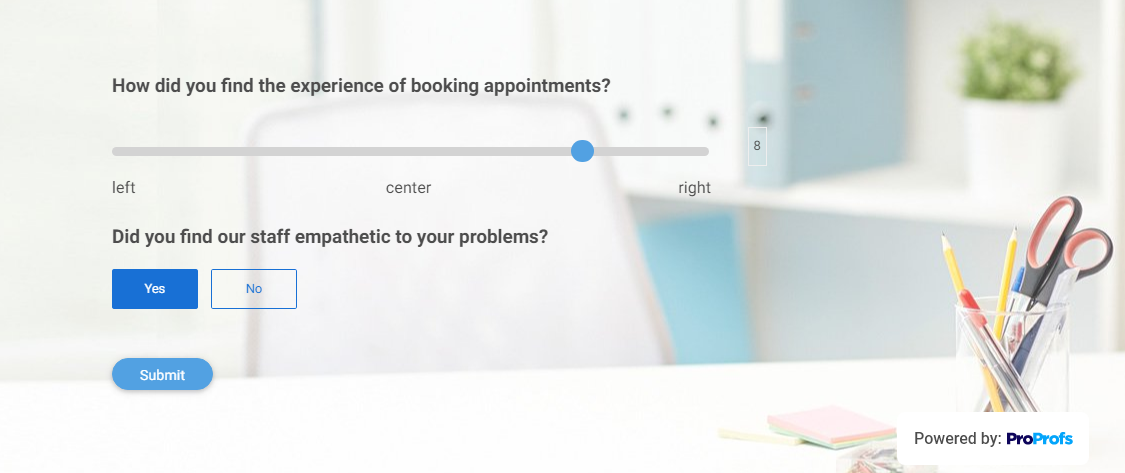
Source: ProProfs Survey Maker
ProProfs Survey Maker is a practical option for medical practices that need to collect patient feedback, run health assessments, and measure satisfaction in a structured way. Powered by advanced AI technology, the platform can generate complete surveys in seconds for any healthcare need, create tailored questions effortlessly, and provide AI-driven insights from patient responses. With support for 70+ languages, the AI capabilities help practices save significant time and resources while ensuring comprehensive patient engagement.
The platform comes with 100+ ready-to-use templates and a large question library, helping practices get started quickly. Its advanced reporting and analytics turn responses into insights that highlight patient concerns, monitor satisfaction trends, and support quality improvement initiatives.
It also integrates with popular business and healthcare tools, making it easier to manage survey data alongside other systems. Patients can be reached through email, links, or website embeds, giving providers flexible ways to gather responses. HIPAA compliance is available on higher-tier plans, making it suitable for providers handling sensitive health data.
Pros:
- Easy-to-use interface enabling a clutter-free, smooth user experience
- 100+ pre-built templates and 20+ survey question types
- Advanced features, including conditional logic and survey redirects
- Advanced reporting and analytics with catchy, graphical representations of survey results
- Extensive and helpful product knowledge base and tooltips embedded within the software
- Smart triggers to allow a survey to pop up after a certain time limit, percentage of page scrolled, or right before the exit
Cons:
- The app is prone to suffering minor glitches from time to time
- The basic plan is limited to just one administrator
Pricing:
A free plan is available for up to 50 responses. Paid plan starts at $19.99/month.
Watch: How to Create a Survey Using ProProfs Survey Maker
2. Spruce Health – Best for Secure Patient Communication
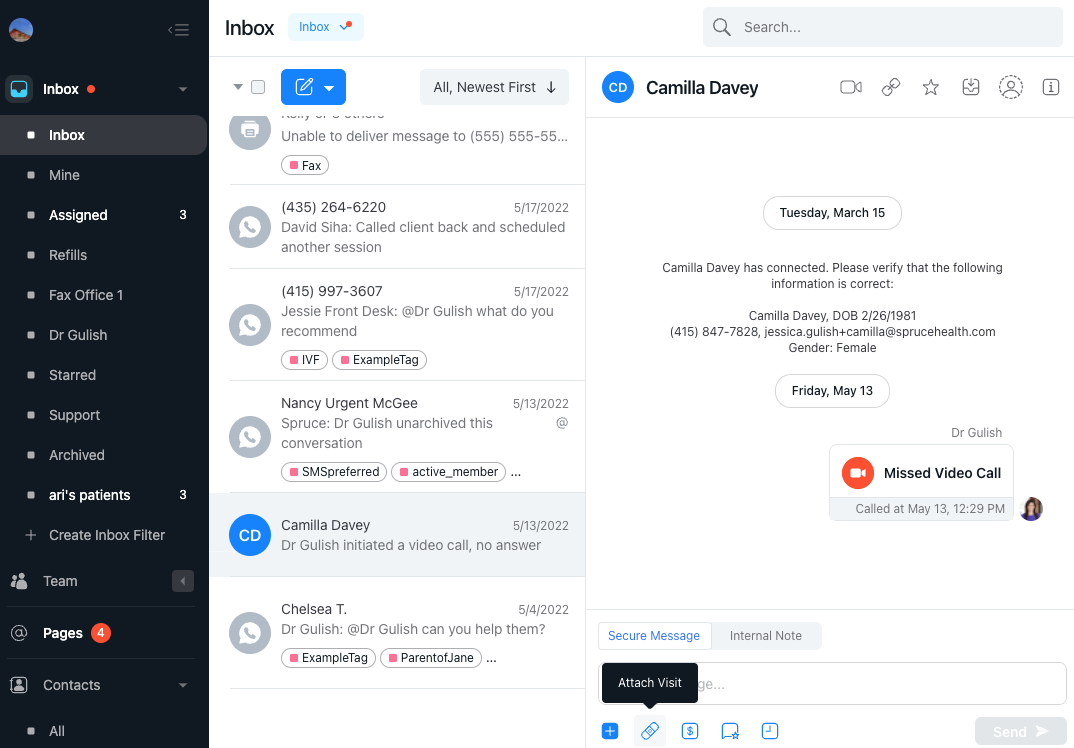
Source: Spruce Health
From my experience, I believe Spruce Health is an ideal solution for enhancing patient engagement in healthcare.
One of the standout functionalities of Spruce Health is its HIPAA-compliant patient communication feature. With secure messaging and video visits, patients can easily connect with healthcare providers while ensuring their privacy and security.
This enables convenient remote consultations, efficient follow-ups, and seamless communication between patients and doctors.
In addition, the tool enables patients to access their medical records and test results, schedule appointments, and receive reminders, all through a user-friendly patient portal.
Even more, Spruce Health provides valuable resources and educational materials to empower patients to take an active role in their healthcare journey!
Pros:
- HIPAA-compliant secure messaging and file sharing for private and secure patient-provider communication
- SMS texting and voicemail transcription for enhanced efficiency and convenience
- Secure video calling for virtual visits, enabling remote consultations and reducing the need for in-person appointments
- E-faxing capabilities to streamline communication and securely send and receive fax documents
- Team messaging with task assignments for effective collaboration and coordination among healthcare providers
- Clinical questionnaires for screening patients, ensuring comprehensive and accurate medical information
Cons:
- The chat support is mostly operated by AI and takes a long time to switch over to human support agents
- No spam-protection options while exchanging FAXes
Pricing:
Basic plan starts at $24/month
3. NextGen Office – Best for Seamless Patient Management
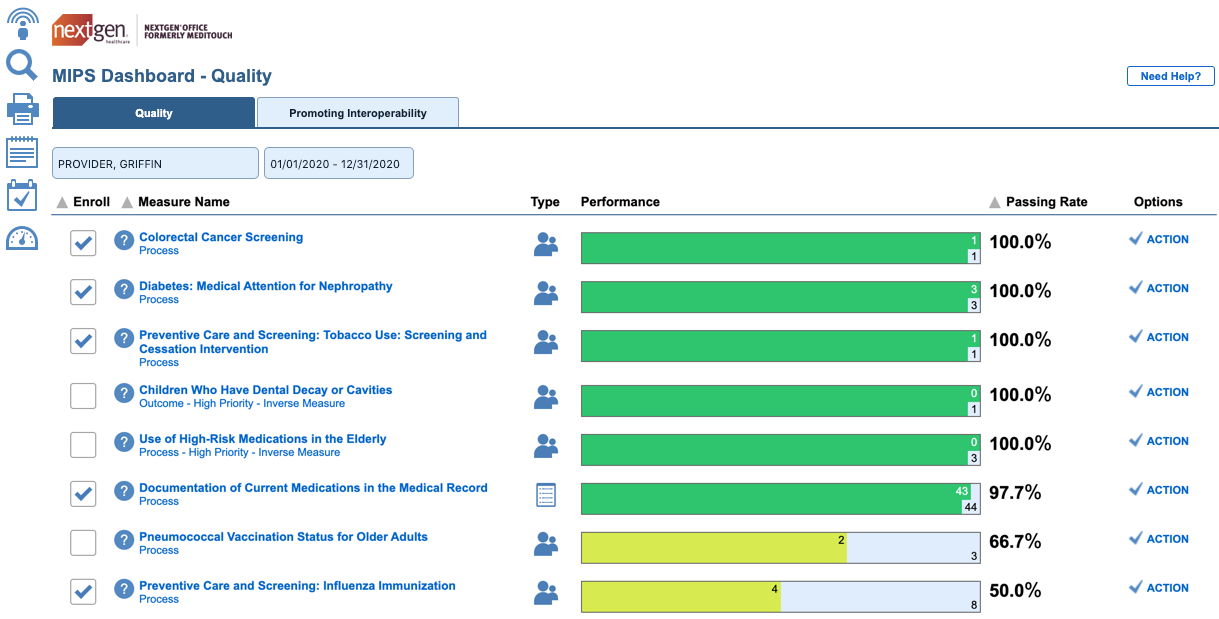
Source: NextGen Office
With its user-friendly interface and comprehensive features, NextGen Office has greatly enhanced my ability to engage with patients and provide them with personalized care.
The best use case of NextGen Office lies in its cloud-based comprehensive patient management system. It allows me to streamline all aspects of patient care, from scheduling appointments and managing medical records to conducting telehealth visits.
The tool also empowers patients with self-scheduling options, provides a patient portal for secure communication and access to medical information, and enables easy integration with other healthcare systems.
These features combine to create a seamless and interactive environment for patients, promoting better engagement, satisfaction, and overall health outcomes.
Pros:
- Intuitive and streamlined cloud-based EHR & EPM software
- Easy access to training and support to enhance the care experience
- Streamlined scheduling, medical records, and telehealth visits with comprehensive patient management
- Patients can securely communicate and access medical information through a patient portal
- Providers can save time and reduce stress with mobile solutions for digital documentation and remote access
- Automated billing and revenue cycle management to mitigate billing challenges
Cons:
- Steep learning curve
- Customer support could be improved
Pricing:
Contact the company for a quote.
4. AthenaOne – Best for All-in-One Patient Management
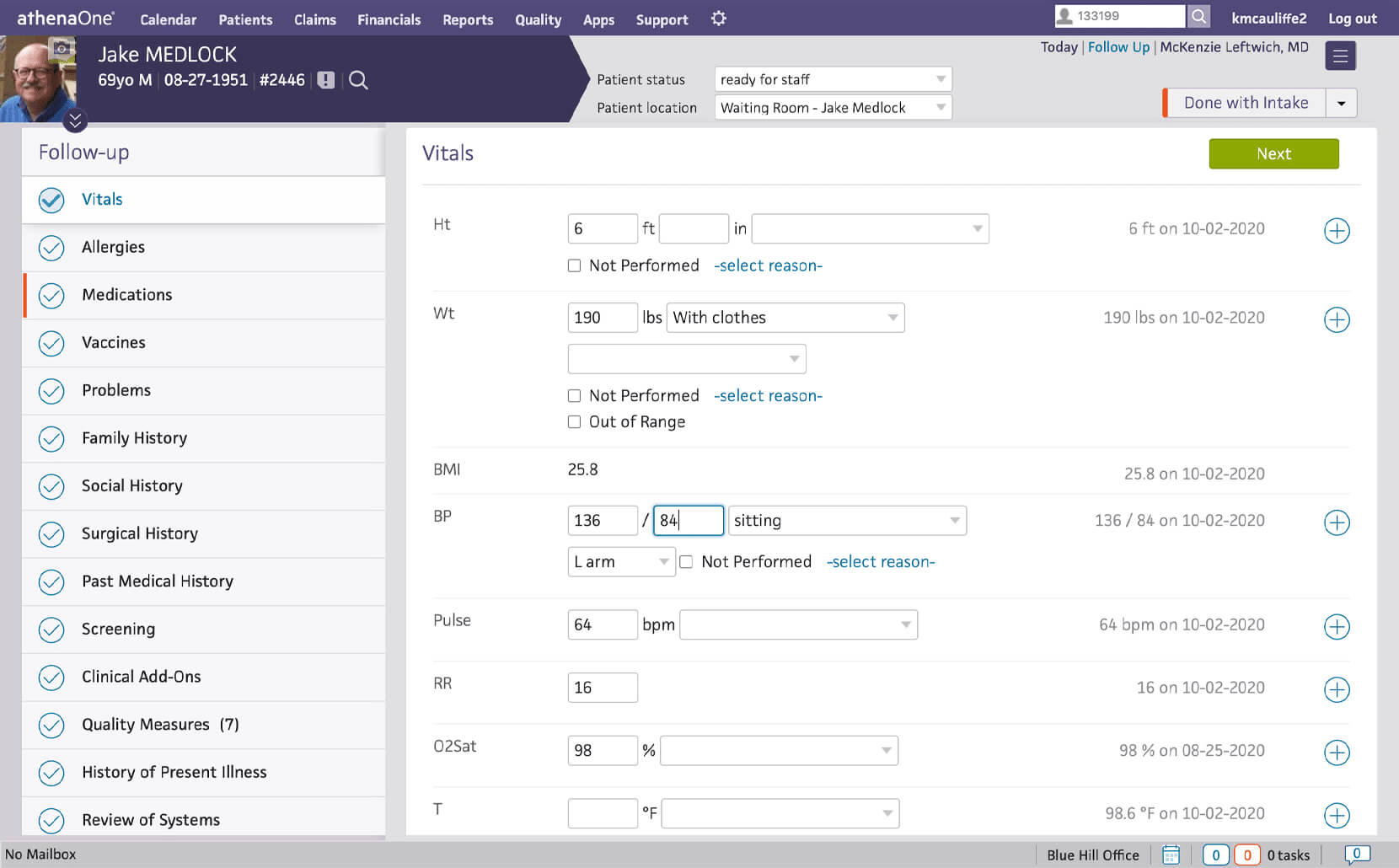
Source: AthenaOne
AthenaOne stands out due to its ability to streamline clinical and administrative workflows, providing comprehensive patient management solutions.
With customizable documentation templates and automatic patient record sharing, delivering high-quality care becomes effortless.
AthenaOne’s best use case lies in its capability to handle both clinical and administrative aspects of patient management. From seamless electronic health records management to efficient revenue cycle services, it ensures smooth operations for medical practices of all sizes.
It reduces billing time, offers enhanced claim resolution, and even gamifies revenue cycle processes for better outcomes. The all-encompassing nature of AthenaOne makes it unmatched in providing comprehensive patient management.
Pros:
- Integrated Network Solution & mobile capabilities for on-the-go clinical work
- Voice Solutions for hands-free clinical efficiency
- Customizable documentation templates for easy delivery of quality care
- Revenue Cycle Services for efficient medical billing and practice management
- Enhanced Claim Resolution support to recover payments and rework claim denials
- Gamified revenue cycle processes for improved billing and staff productivity
Cons:
- The UI is disorganized and may not feel easy while using
- Customer support service needs improvement
Pricing:
Contact the company for a quote.
5. Mend – Best for Telemedicine Dispatch

Source: Mend
Mend truly transforms how healthcare providers engage with patients, improving outcomes and delivering excellent patient satisfaction.
The tool excels in telemedicine patient engagement capabilities. Through its innovative video conferencing and messaging features, healthcare providers can connect with patients remotely, enabling virtual consultations and follow-ups.
This functionality eliminates geographical barriers and enhances accessibility to healthcare, allowing patients to receive the care they need from the comfort of their own homes.
Other than that, Mend also offers an appointment scheduling and reminder system to ensure seamless coordination and reduce no-shows, while the secure messaging functionality enables quick and secure communication between healthcare providers and patients.
With its patient portal, patients can access their medical records, request prescription refills, and engage in their healthcare journey actively.
Pros:
- HIPAA-compliant telemedicine for secure virtual consultations.
- Automated patient payments to streamline and simplify the payment process.
- Digital intake forms for a hassle-free intake process for patients.
- Group video scheduling for collaborative healthcare discussions.
- Telepsychiatry software for remote mental health care.
- Patient appointment reminders to reduce no-shows and improve attendance.
Cons:
- Can be difficult to log on to mobile devices
- Occasional glitches can cause uploaded data to disappear
Pricing:
Starts at $49.99/user/month
6. PracticeFusion – Best for Patient Management for Independent Practices
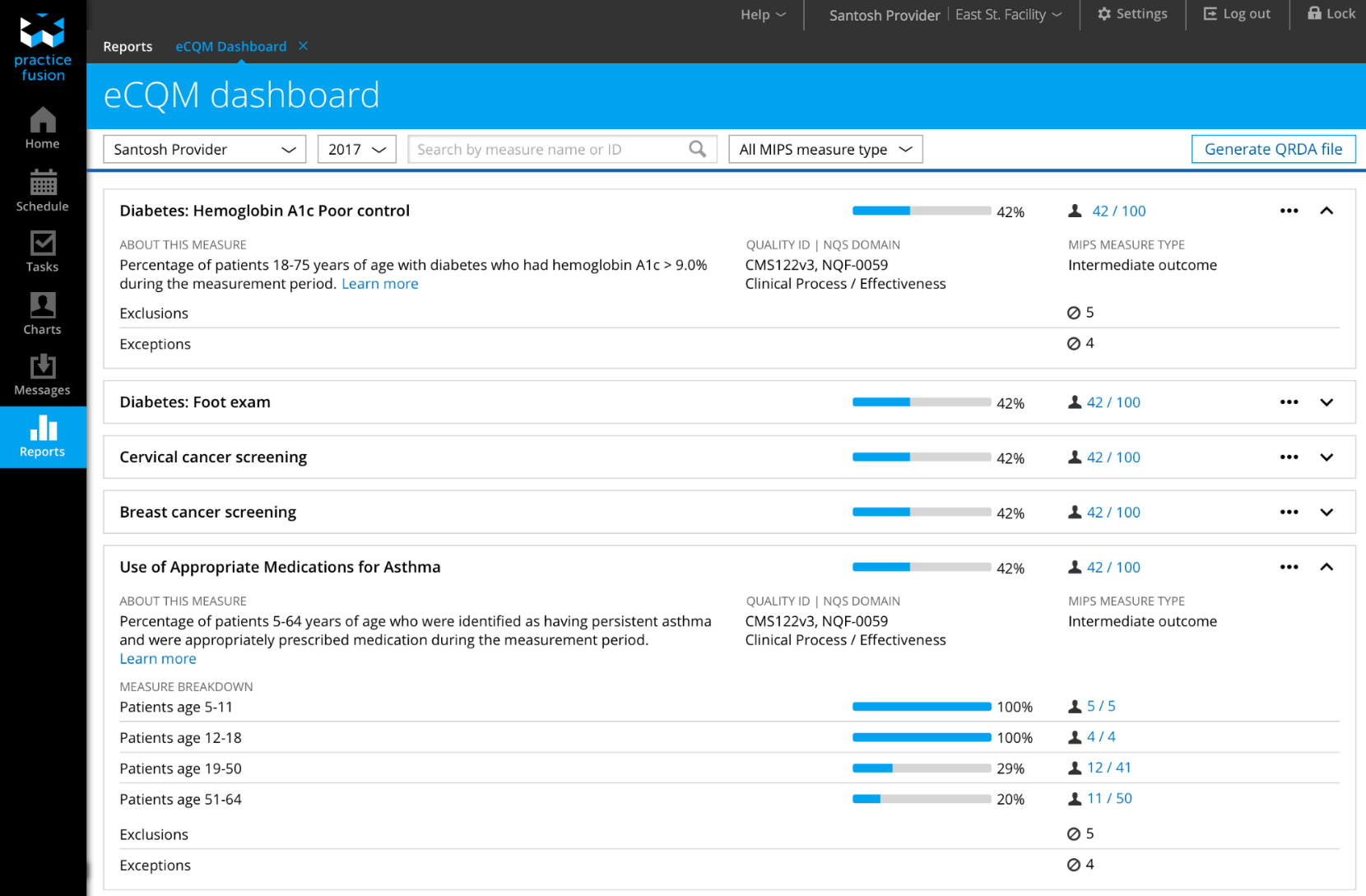
Source: PracticeFusion
PracticeFusion also provides tools for telehealth, allowing the convenience of secure and effective telemedicine for both patients and healthcare providers.
The tool offers a comprehensive suite of tools enabling independent practices like mine to deliver personalized, attentive care to our patients without compromising on efficiency.
PracticeFusion, in my opinion, is best suited for independent practices. Its advanced features such as appointment scheduling, e-prescribing, and customizable clinical charting, make it an ideal choice for smaller or lower-volume healthcare providers.
Adding to it, its patient portal lets patients access their medical information and communicate with their care providers quickly and intuitively.
Pros:
- Streamlined charting with customizable notes and templates adapted to patient needs
- Easily managed prescriptions with the option to send them to any e-Prescribing enabled pharmacy
- Seamless exchange of information with local pharmacies, laboratories, and imaging centers for better care coordination
- Simplified billing with flexible options and collaboration with industry-leading partners
- Option to monitor progress and submit reporting data to CMS directly through insightful dashboards
- Convenient cloud-based EHR with automatic updates, secure data backup, and HIPAA compliance
Cons:
- Steep hikes in pricing modules frequently
- Glitches in the payment system while subscribing to the software
Pricing:
Starts at $149/provider/month.
7. PrognoCIS – Best for Improving Overall Patient Experience
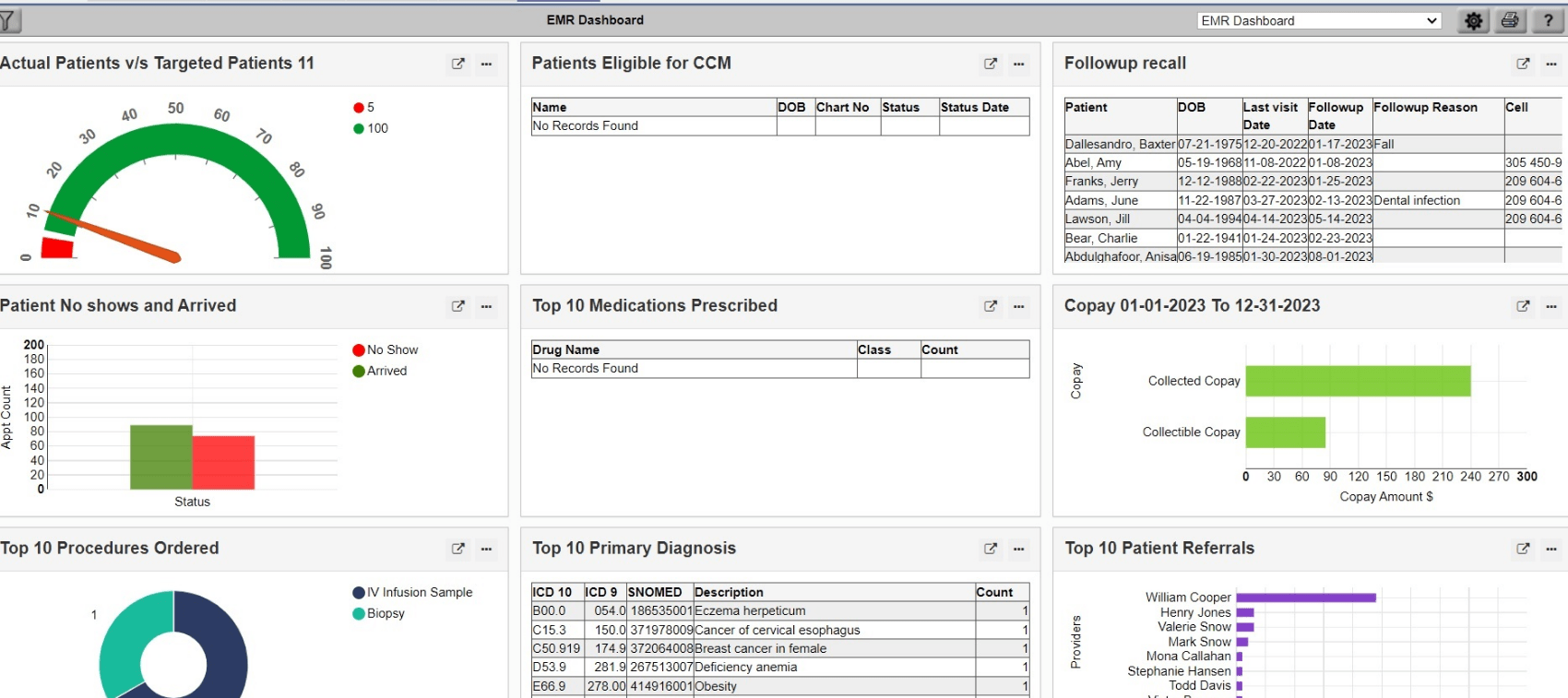
Source: PrognoCIS
With over 10 years of experience and a proven track record, PrognoCIS is a reliable software solution that can enhance both practice efficiency and patient satisfaction.
Its HIPAA-compliant electronic health record (EHR) system streamlines all aspects of practice management, including patient scheduling, billing, and charting.
With the interactive patient portal, patients can take an active role in their healthcare by reviewing their medical records, scheduling appointments, paying bills online, and communicating with their healthcare providers.
Other features that make PrognoCIS a great patient engagement software include its e-prescribing technology, which improves prescription accuracy, minimizes lost or unfilled prescriptions, and saves time.
The customizable dashboards provide valuable insights into the progress of the practice, while seamless integrations with Labs, Radiology Companies, Vaccine Registries, and more speed up the ordering, resulting, and reporting processes.
Pros:
- HIPAA-compliant electronic health records (EHR) with appointment scheduling, billing, and order management
- Customizable and informative dashboards to track the progress of your practice
- Interactive patient portal for enhanced patient engagement, including document sharing, messaging, and online payments
- E-prescribing technology for improved prescription accuracy and time savings
- Seamless integrations with labs, radiology companies, vaccine registries, and more for streamlined ordering and reporting processes
- PrognoFax feature for quick and easy faxing without the need for hardware installation
Cons:
- Poor & deficient customer service
- Occasional data loss occurs due to glitches
Pricing:
Starts at $249/month
8. Solutionreach – Best for Patient Communication
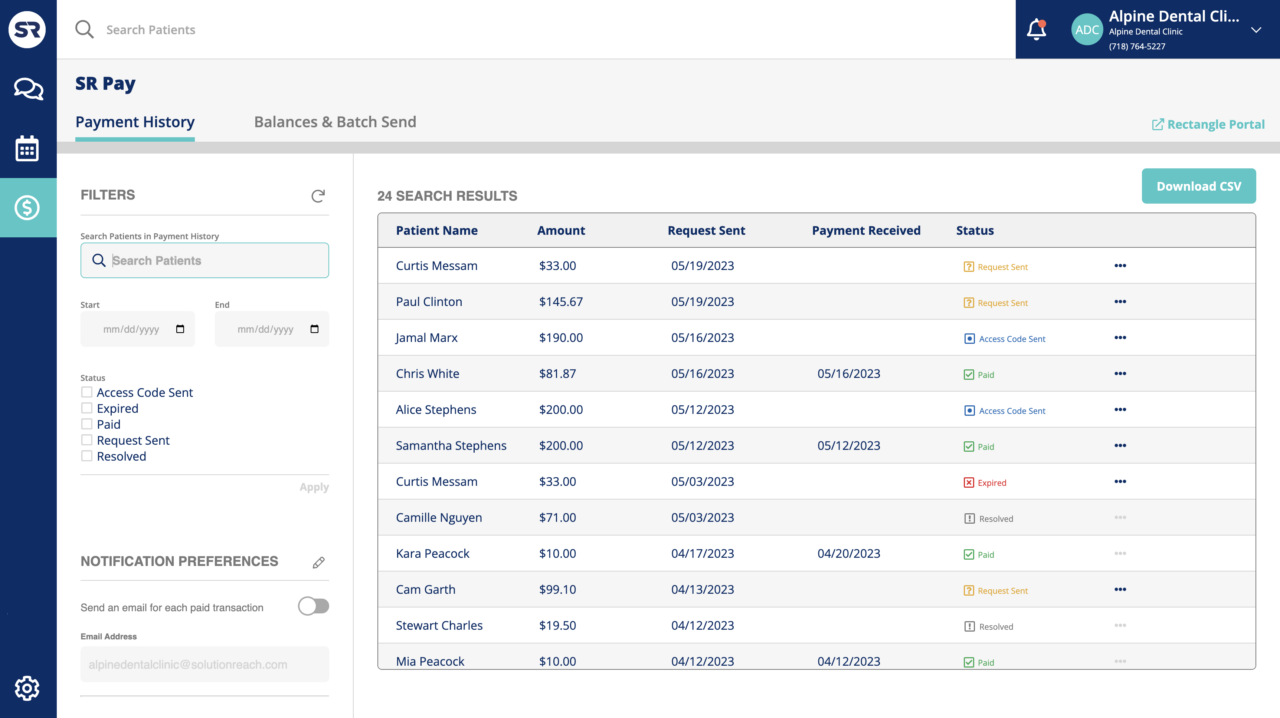
Image source: Solutionreach
Solutionreach is an excellent patient management software that helps healthcare practices transform their patient experience.
With its user-friendly interface and robust features, Solutionreach streamlines administrative tasks and enhances practice efficiency.
It offers automated appointment reminders, personalized messages, and two-way text communications, allowing healthcare providers to engage with patients in a convenient and timely manner, resulting in improved patient satisfaction and reduced no-shows.
In addition to patient communication, Solutionreach also offers online scheduling, reputation management, patient surveys, and post-visit follow-up tools, all designed to optimize patient engagement and improve overall practice outcomes.
Pros:
- Improved staff efficiency with digital-first processes and automated communications
- Revenue boost through end-to-end revenue cycle managing capabilities
- Personalized messaging for improved patient engagement and retention
- Easy online scheduling and appointment reminders via text
- HIPAA-compliant communication and data security
- Automated marketing and education campaigns for improved patient outreach.
Cons:
- No option for patients to leave reviews about the service received
- Canceling subscription requires 30 days of prior notice
Pricing:
Contact the company for a quote.
9. ModMed – Best for Specialty-Specific EHR Systems
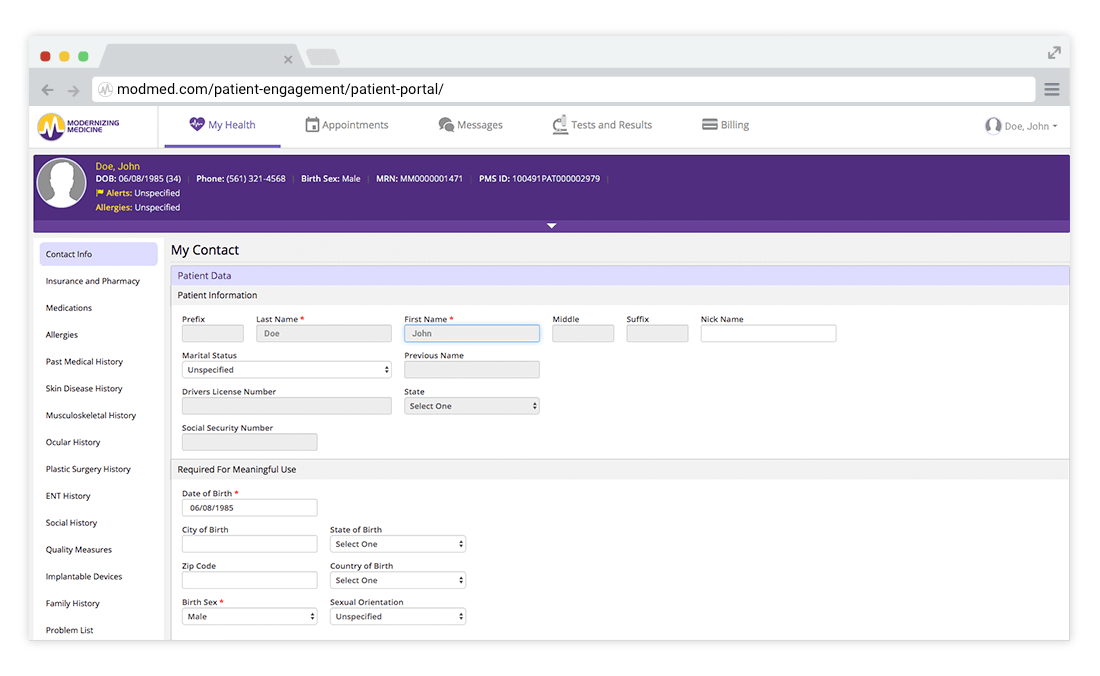
Image source: ModMed
ModMed is an exceptional patient engagement software that revolutionizes the way healthcare providers manage patient information.
With its user-friendly interface and advanced features, ModMed empowers healthcare professionals to access, update, and share patient records seamlessly, improving overall accuracy and collaboration.
One of the key strengths of ModMed lies in its specialty-specific Electronic Health Record (EHR) systems. Whether it’s cardiology, dermatology, or any other specialty, ModMed offers tailored solutions that cater to the unique needs of each practice.
The tool also boasts other remarkable features that make it an exceptional patient engagement software. Its patient portal allows patients to securely access their medical records, review their appointments, and communicate with their healthcare providers.
Furthermore, ModMed offers convenient online appointment scheduling, integrated telemedicine capabilities, and automated reminders, enhancing patient engagement and satisfaction.
Pros:
- Specialty-specific EHR Systems for Allergy, Dermatology, Gastroenterology, OBGYN, Ophthalmology, Orthopedics, Otolaryngology, Pain Management, Plastic Surgery, Podiatry, and Urology
- Practice Management solutions for streamlined scheduling, document management, and billing
- Revenue Cycle Management services for increased financial visibility and faster revenue cycles
- Intuitive healthcare software solutions designed by practicing physicians for enhanced patient care
- Gastro Endoscopy Report Writer for optimizing ASC or hospital workflows in gastrointestinal practice
- Advisory Services that support practices in value-based care solutions and successful implementations
Cons:
- No direct access to the support team except through emails
- The UI could be more organized
Pricing:
Starts at $197/month
10. RXNT – Best for Simplifying Workflow
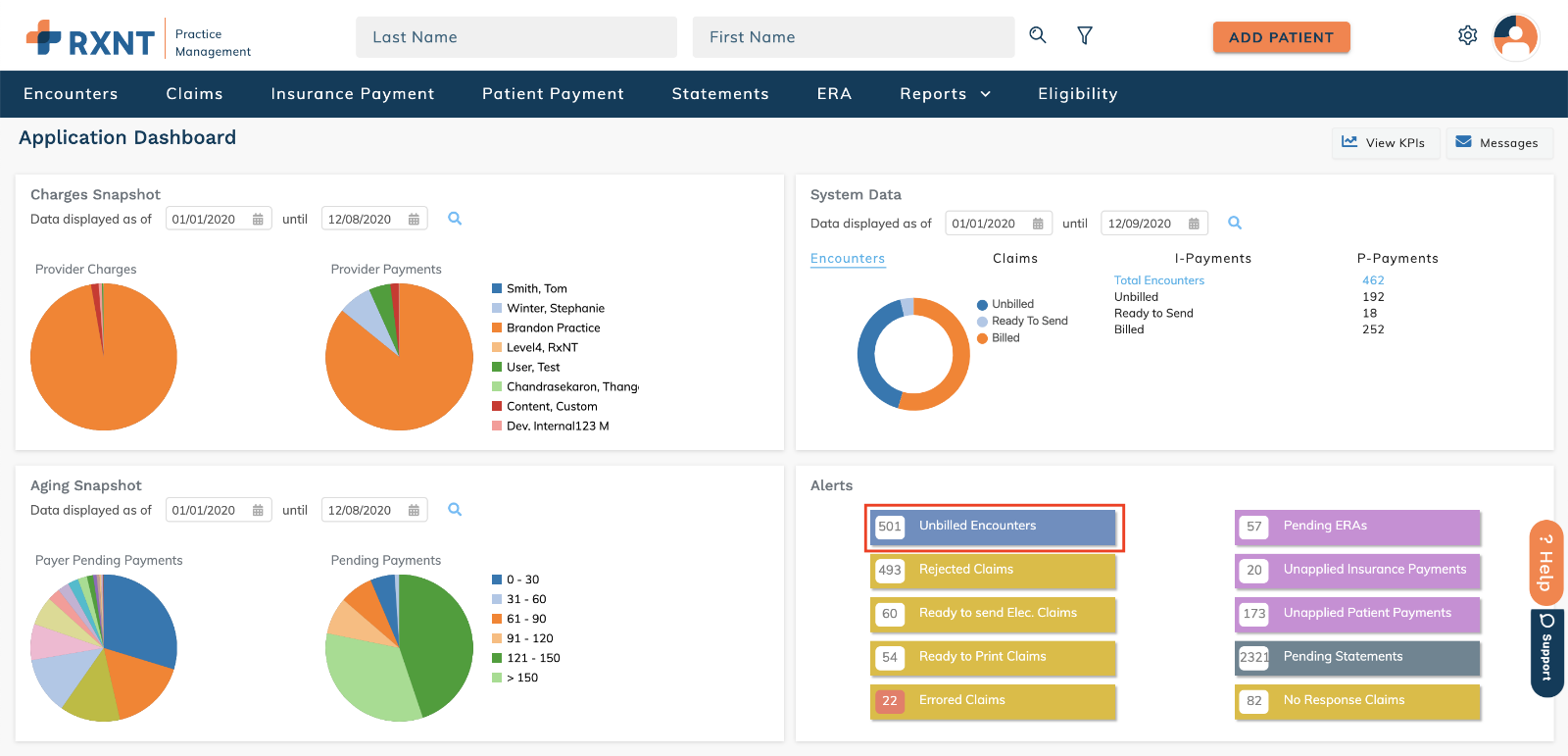
Image source: RXNT
As a patient engagement software, RXNT stands out as a reliable and comprehensive solution for managing healthcare practices.
The best use case for RXNT lies in its ability to streamline the entire healthcare workflow, from scheduling appointments to managing electronic health records and prescribing medications.
By centralizing these processes, RXNT eliminates the need for manual tasks and reduces the risk of errors, allowing healthcare providers to focus more on patient care.
RXNT also offers a range of features, such as mobile-friendly patient portals, access to medical records, and convenient appointment scheduling, that empower patients to actively participate in their healthcare journey and facilitate seamless communication between patients and healthcare providers.
Pros:
- Cloud-based integrated healthcare software for simplified access and seamless collaboration
- Comprehensive practice management system for efficient scheduling, billing, and revenue cycle management
- Electronic Health Records (EHR) with customizable charting, reports, and mobile apps for improved patient care
- Electronic Prescribing (eRx) functionality for secure and convenient medication prescription
- Patient engagement tools, including patient portals and mobile apps, for enhanced communication and involvement
- Streamlined medical scheduling and telehealth capabilities for convenient and accessible healthcare services
Cons:
- Clunky & disorganized user interface
- Difficult to schedule multiple appointments
Pricing:
Starts at $110/month
How We Evaluated These Tools
Not every tool that calls itself patient engagement software delivers what practices really need. To keep this guide useful, we evaluated each platform against criteria that reflect the most significant challenges healthcare teams face today. These criteria come directly from user feedback, community discussions, and real-world pain points.
1. Integration With EHR and EMR Systems
A tool that does not integrate smoothly with existing systems only creates more duplicate work and fragmented data. Many providers in community discussions shared frustration with “add-on” tools that require staff to manually transfer information between systems.
2. Ease of Use for Staff and Patients
Even the most feature-rich platforms fail if staff find them confusing or if patients struggle to log in. We paid close attention to whether users described the interface as intuitive and whether adoption rates were high or low.
3. HIPAA Compliance and Data Security
Privacy is non-negotiable. We considered whether platforms offered Business Associate Agreements (BAAs), secure encryption, and compliance without tacking on hidden fees, a pain point repeatedly flagged in our research.
4. Communication Features
Tools that only send generic reminders are no longer enough. The best patient engagement platforms enable two-way communication through SMS, email, or secure portals, with the ability to personalize outreach based on patient history.
5. Analytics and Insights
Several providers highlighted that their current systems keep them reactive rather than proactive. We looked for platforms that offer reporting and predictive insights to reduce no-shows, track satisfaction, and inform care decisions.
6. User Reviews and Reputation
Beyond vendor promises, we analyzed feedback from healthcare professionals in forums and review sites. Complaints about steep learning curves, hidden costs, or poor customer support carried significant weight in our evaluation.
7. Value for Money
Budgets are tight, especially for small practices. We compared pricing models, looking at whether features considered “basic,” such as SMS reminders, required costly upgrades.
These criteria ensure that the top patient engagement solutions highlighted in this guide reflect not just marketing claims but the lived reality of providers and staff who use them daily.
Best Picks for Different Needs
Choosing the right patient engagement software depends on the size of your practice, the type of patients you serve, and the problems you need solved first. Here are the standouts based on different priorities:
1. Best for Surveys and Feedback: ProProfs Survey Maker
Perfect for practices that want to measure patient satisfaction, run health assessments, and collect feedback without overwhelming staff. Its strength lies in turning responses into data-driven insights that help improve care quality and patient experience.
2. Best for Secure Communication: Spruce Health
It is ideal for clinics and practices where HIPAA-compliant communication is critical. Secure messaging, video visits, and team collaboration tools make patient-provider conversations easier and safer, reducing the reliance on clunky phone calls and fax machines.
3. Best for Independent Practices: PracticeFusion
Designed with smaller practices in mind, PracticeFusion offers an affordable balance of core features like e-prescribing, patient portals, and telehealth. It gives solo practitioners the essentials without the overhead of larger systems.
4. Best All-in-One: AthenaOne
A comprehensive option for larger practices that need everything under one roof. AthenaOne combines clinical workflows, billing, and engagement features into a single platform, making it easier to manage both patient care and practice operations at scale.
5. Best Specialty-Focused: ModMed
Built specifically for medical specialties, ModMed provides tailored workflows for fields like dermatology, orthopedics, and ophthalmology. Its specialty-specific EHRs and engagement tools save time and reduce friction for providers with unique practice needs.
FREE. All Features. FOREVER!
Try our Forever FREE account with all premium features!
Which One Is Right for You?
The best patient engagement software for your practice depends less on the features vendors push and more on the problems you need solved first. Here’s how to think about it:
1. Solo Practitioners
Look for cost-effective tools that you can set up quickly without outside IT support. Prioritize ease of use and simple feedback collection so you can understand patient needs without adding admin stress.
2. Small to Mid-Size Practices
Focus on platforms that combine secure communication with scheduling and reminders. At this stage, reducing no-shows and keeping patients connected between visits will have the biggest impact on both satisfaction and revenue.
3. Large Practices and Health Systems
You’ll need enterprise-level solutions that can unify billing, clinical workflows, and engagement under one platform. Pay attention to integration strength with your existing EHR and the ability to support multiple departments and locations.
4. Specialty Practices
Choose systems designed with your field in mind. Specialty-focused workflows reduce the time staff spend customizing generic templates and make it easier to deliver care that matches your practice’s unique needs.
5. Telehealth-Heavy Practices
Prioritize platforms with reliable video, digital intake, and automated reminders. Strong telehealth support ensures patients actually show up for virtual visits and can access care without technical headaches.
Making Patient Engagement Software Work for Your Practice
Patient engagement software is no longer optional for practices that want to improve satisfaction, reduce no-shows, and keep patients actively involved in their care. The challenge is finding a solution that fits your size, budget, and workflow without overwhelming your staff.
If your priority is collecting feedback and using it to drive quality improvements, ProProfs Survey Maker offers one of the most straightforward and affordable ways to get started.
The most important step is to match the tool to your practice’s immediate needs instead of chasing every feature on the market. Start small if you have to, test free trials where available, and involve staff in the process to make sure adoption sticks.
The software is only part of the solution. True patient engagement comes from building a culture of clear communication and collaboration, where patients feel heard and supported throughout their care journey.
Frequently Asked Questions
How do I ensure HIPAA compliance with these tools?
Always confirm that the patient engagement solution you choose offers a Business Associate Agreement (BAA), uses end-to-end encryption, and provides role-based access controls. Reputable vendors also undergo regular security audits. Do not rely on marketing claims alone — request and review compliance documentation before implementation.
What Is the typical ROI timeline for patient engagement software?
Practices adopting the right patient engagement tools often see results within 3 to 6 months. Common improvements include reduced no-show rates by 15 to 30 percent, lower administrative workload by 20 to 40 percent, and stronger patient retention. These outcomes depend on how well the software integrates with workflows and how consistently staff and patients use it.
Can these tools integrate with my existing EHR system?
Most modern patient engagement platforms are designed to connect with leading EHR and EMR systems. Integration depth varies, so it is important to check compatibility with your specific vendor. Look for solutions that offer two-way data sync so patient information and engagement records stay up to date across systems.
 Tips
Tips
We’d love to hear your tips & suggestions on this article!
FREE. All Features. FOREVER!
Try our Forever FREE account with all premium features!


 We'd love your feedback!
We'd love your feedback! Thanks for your feedback!
Thanks for your feedback!


